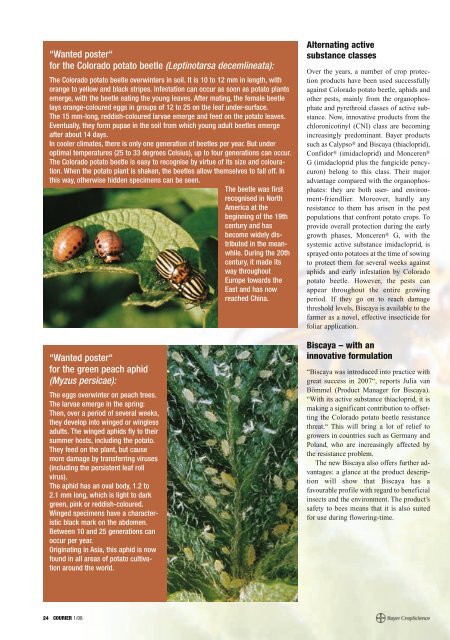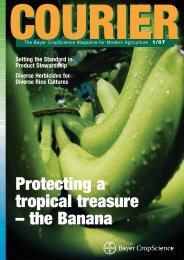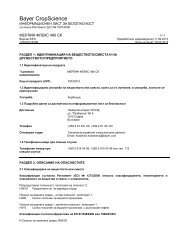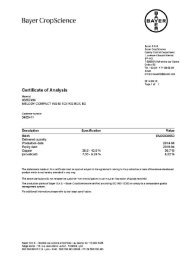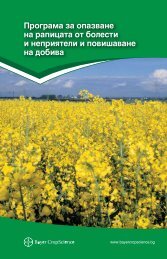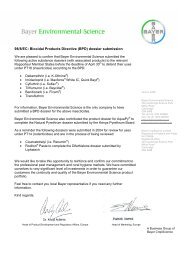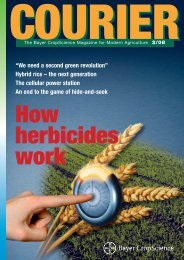Potatoes⦠- Bayer CropScience
Potatoes⦠- Bayer CropScience
Potatoes⦠- Bayer CropScience
You also want an ePaper? Increase the reach of your titles
YUMPU automatically turns print PDFs into web optimized ePapers that Google loves.
“Wanted poster“<br />
for the Colorado potato beetle (Leptinotarsa decemlineata):<br />
The Colorado potato beetle overwinters in soil. It is 10 to 12 mm in length, with<br />
orange to yellow and black stripes. Infestation can occur as soon as potato plants<br />
emerge, with the beetle eating the young leaves. After mating, the female beetle<br />
lays orange-coloured eggs in groups of 12 to 25 on the leaf under-surface.<br />
The 15 mm-long, reddish-coloured larvae emerge and feed on the potato leaves.<br />
Eventually, they form pupae in the soil from which young adult beetles emerge<br />
after about 14 days.<br />
In cooler climates, there is only one generation of beetles per year. But under<br />
optimal temperatures (25 to 33 degrees Celsius), up to four generations can occur.<br />
The Colorado potato beetle is easy to recognise by virtue of its size and colouration.<br />
When the potato plant is shaken, the beetles allow themselves to fall off. In<br />
this way, otherwise hidden specimens can be seen.<br />
The beetle was first<br />
recognised in North<br />
America at the<br />
beginning of the 19th<br />
century and has<br />
become widely distributed<br />
in the meanwhile.<br />
During the 20th<br />
century, it made its<br />
way throughout<br />
Europe towards the<br />
East and has now<br />
reached China.<br />
“Wanted poster“<br />
for the green peach aphid<br />
(Myzus persicae):<br />
The eggs overwinter on peach trees.<br />
The larvae emerge in the spring:<br />
Then, over a period of several weeks,<br />
they develop into winged or wingless<br />
adults. The winged aphids fly to their<br />
summer hosts, including the potato.<br />
They feed on the plant, but cause<br />
more damage by transferring viruses<br />
(including the persistent leaf roll<br />
virus).<br />
The aphid has an oval body, 1.2 to<br />
2.1 mm long, which is light to dark<br />
green, pink or reddish-coloured.<br />
Winged specimens have a characteristic<br />
black mark on the abdomen.<br />
Between 10 and 25 generations can<br />
occur per year.<br />
Originating in Asia, this aphid is now<br />
found in all areas of potato cultivation<br />
around the world.<br />
Alternating active<br />
substance classes<br />
Over the years, a number of crop protection<br />
products have been used successfully<br />
against Colorado potato beetle, aphids and<br />
other pests, mainly from the organophosphate<br />
and pyrethroid classes of active substance.<br />
Now, innovative products from the<br />
chloronicotinyl (CNI) class are becoming<br />
increasingly predominant. <strong>Bayer</strong> products<br />
such as Calypso ® and Biscaya (thiacloprid),<br />
Confidor ® (imidacloprid) and Monceren ®<br />
G (imidacloprid plus the fungicide pencycuron)<br />
belong to this class. Their major<br />
advantage compared with the organophosphates:<br />
they are both user- and environment-friendlier.<br />
Moreover, hardly any<br />
resistance to them has arisen in the pest<br />
populations that confront potato crops. To<br />
provide over all protection during the early<br />
growth phases, Monceren ® G, with the<br />
systemic active substance imidacloprid, is<br />
sprayed onto potatoes at the time of sowing<br />
to protect them for several weeks against<br />
aphids and early infestation by Colorado<br />
potato beetle. However, the pests can<br />
appear throughout the entire growing<br />
period. If they go on to reach damage<br />
threshold levels, Biscaya is available to the<br />
farmer as a novel, effective insecticide for<br />
foliar application.<br />
Biscaya – with an<br />
innovative formulation<br />
“Biscaya was introduced into practice with<br />
great success in 2007“, reports Julia van<br />
Bömmel (Product Manager for Biscaya).<br />
“With its active substance thiacloprid, it is<br />
making a significant contribution to offsetting<br />
the Colorado potato beetle resistance<br />
threat.“ This will bring a lot of relief to<br />
growers in countries such as Germany and<br />
Poland, who are increasingly affected by<br />
the resistance problem.<br />
The new Biscaya also offers further advantages:<br />
a glance at the product description<br />
will show that Biscaya has a<br />
favourable profile with regard to beneficial<br />
insects and the environment. The product’s<br />
safety to bees means that it is also suited<br />
for use during flowering-time.<br />
24 COURIER 1/08


